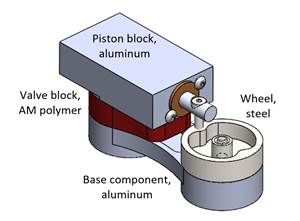Contingent Staffing for the Machining Job Shop
Hiring additional staff is an option to increase capacity, but if the fluctuation in demand is unpredictable and of short duration, you can quickly end up with excess capacity and a fixed expense that is too large for a lower level of business.
Share





Hiring additional staff is an option to increase capacity, but if the fluctuation in demand is unpredictable and of short duration, you can quickly end up with excess capacity and a fixed expense that is too large for a lower level of business. Outsourcing the excess demand to qualified sources is another option for adding capacity. However, this method, while viable, can result in less control of work priorities and probably a slower turn-around time than desired. Another, better, alternative is to temporarily employ recently retired shopfloor workers for these short-term assignments.
Developing a labor pool of retired workers who have the knowledge, skill and ability to make immediate contributions is a great strategy for adding temporary capacity. An easy way to build this pool is to encourage retired employees sign up with a temporary staffing agency. Once they are available as employees of the staffing agency, they are only a phone call away from enabling your capacity to increase for an hour, a day, a month or even longer. Retired workers fit into this model best because they are not looking for a full-time job; rather, many are looking for a job that will enable them to contribute to the success of your business while still meeting their personal retirement goals.
There are many benefits for retired workers interested in being part of this contingent workforce. The work allows them to socialize with other retirees of similar background and interests, while earning a supplemental income that can be used to support their retirement hobbies or meet their living expenses. It also enables them to be mentors and coaches to younger workers. Many retired workers want a flexible schedule that allows them to enjoy leisure activities, and this type of work satisfies that desire. Perhaps the biggest benefit is that continuing to work helps them stay mentally alert and physically active. Many retired workers greatly appreciate the opportunity to work in this capacity.
Your shop can also benefit from this type of arrangement. In addition to temporarily meeting the need for highly skilled and knowledgeable workers when demand changes, these retired workers can, in some cases, fill a void created of skilled workers in the general workforce. Other benefits include:
• Retired workers can cover employee vacations.
• Your regular workforce can increase its competency through knowledge gained by working with seasoned veterans.
• Routine tasks can be assigned or structured to best suit the flex staff, allowing your regular staff to focus on critical activities.
• The retired workers’ flexible schedules should easily fit into the company’s need for schedule flexibility.
• You can maintain control of and prioritize work for quick turn-around or whatever your needs might be.
• The cost to employ these workers is variable; so, when the demand drops off, it is easy to reduce expenses by not employing them. They know when the demand increases again, they will be called back. This model is much different from the “hire and layoff” scenario that is sometimes necessary if business demand drops off and expenses need to be cut.
To be successful with this strategy, you must have a good number of retirees in the pool from which to draw, as it is possible for a large number of workers to be unavailable during certain times of the year. If you are successful in developing this labor pool of retirees, however, you should be able to meet your business needs and the contingent workers’ needs while keeping your customers happy.
About the Author
Larry D. Larson is a retired manager of a precision machining prototype job shop and director of engineering for a major electronics test and measurement equipment company. He is currently an adjunct faculty member for the College of Engineering at George Fox University, teaching materials and processes of manufacturing. He has a bachelor’s degree in mechanical engineering technology and a master’s degree in science and technology management.
Related Content
Solve Worker Shortages With ACE Workforce Development
The America’s Cutting Edge (ACE) program is addressing the current shortage in trained and available workers by offering no-cost online and in-person training opportunities in CNC machining and metrology.
Read MoreIn Moldmaking, Mantle Process Addresses Lead Time and Talent Pool
A new process delivered through what looks like a standard machining center promises to streamline machining of injection mold cores and cavities and even answer the declining availability of toolmakers.
Read MoreBuilding Machines and Apprenticeships In-House: 5-Axis Live
Universal machines were the main draw of Grob’s 5-Axis Live — though the company’s apprenticeship and support proved equally impressive.
Read MoreHow to Pass the Job Interview as an Employer
Job interviews are a two-way street. Follow these tips to make a good impression on your potential future workforce.
Read MoreRead Next
Registration Now Open for the Precision Machining Technology Show (PMTS) 2025
The precision machining industry’s premier event returns to Cleveland, OH, April 1-3.
Read MoreBuilding Out a Foundation for Student Machinists
Autodesk and Haas have teamed up to produce an introductory course for students that covers the basics of CAD, CAM and CNC while providing them with a portfolio part.
Read MoreSetting Up the Building Blocks for a Digital Factory
Woodward Inc. spent over a year developing an API to connect machines to its digital factory. Caron Engineering’s MiConnect has cut most of this process while also granting the shop greater access to machine information.
Read More

































